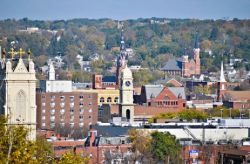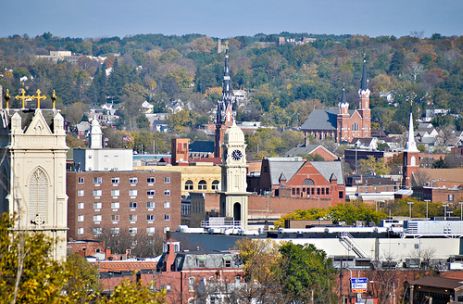
Dubuque, Iowa, is one city getting a leg up from the feds as it tries to revitalize its downtown. Photo courtesy SD Dirk via Flickr
The word “silos” is most often used to talk about grain or coal, not the federal government. But in the case of transportation and housing — two sectors that accounted for more than 43 percent of the nation’s carbon emissions in 2008 — Washington’s siloed approach of divided, blindered policymaking could put wheat farmers to shame.
The Obama administration is starting to break down those barriers between agencies, asking the Department of Transportation (DOT), the Department of Housing and Urban Development (HUD), and the Environmental Protection Agency (EPA) to take an all-hands-on-deck approach to smart growth. Dubbed the Partnership for Sustainable Communities, the effort aims to provide federal support for localities that want to offer more walkable neighborhoods and cleaner commuting options than the car.
“When it comes to housing, environmental, and transportation policy, it’s time the federal government spoke with one voice,” HUD Secretary Shaun Donovan said this month in a speech that officially tapped his deputy, former Seattle-area official Ron Sims, as the Partnership’s leader and “Designated Silo Buster.”
To smart-growth advocates who have waged long battles against sprawl without much backup from Washington, the Partnership is a cause for celebration. The White House’s 2011 budget request included $527 million for the Partnership, though Congress may not actually allocate the funds. Separately, HUD plans to award $100 million in new grants for regional sustainability plans that integrate transportation, housing, and land use by late summer.
The biggest pot of money for the administration’s smart-growth focus is coming from the stimulus law — $1.5 billion in TIGER grants (Transportation Investment Generating Economic Recovery) for transportation projects that create jobs and help develop livable communities. DOT is administering the program, but it asked HUD and the EPA to help choose the grantees.
“This isn’t a case of HUD and EPA saying, ‘DOT has all this money, let’s get in on it,'” said Will Schroeer, state policy director for Smart Growth America. “This is a case of the agencies reaching out to each other, saying, ‘Your decisions affect us and our decisions affect you — let’s make these decisions together.'”
Shelley Poticha, a longtime transportation reformer who became a senior adviser to the Partnership in July, argues that smart-growth efforts are key to fighting the recession.
“To me this is about helping to rebuild our economy, about growing jobs in terms of making housing more energy-efficient,” she said in an interview. “It’s also about helping places and regions really understand where their economic future is going and how they can use that to be more sustainable.”
But with Democrats facing deficit anxiety within their own ranks and an opposition eager to depict new programs as the encroaching hand of “big government,” it remains to be seen whether the Obama team can translate their energy into significant progress toward denser, more close-knit local development. A bill sponsored by Sen. Chris Dodd (D-Conn.) would officially create an office within HUD to focus on sustainable communities and authorize up to $4 billion in grants over the next four years, but it has yet to see even one vote in committee, leaving the administration to use its own devices and seek one-year infusions of money for the Partnership’s plans.
John Petro, urban policy analyst at the nonprofit Drum Major Institute for Public Policy, offered a consciously pragmatic take on what the Partnership can achieve during an economic downturn.
“It’s making the best of this moment,” he said. “When Obama came into office, transit advocates were giving high-fives, [thinking] that from this moment forward, we’re going to see new priorities from the federal government and even Congress. With the recession and the financial crisis, the situation has changed.”
Veteran urban infrastructure analyst Anthony Flint, of the Lincoln Institute of Land Policy, echoed that perspective but warned that budgetary constraints and political realities could turn into a drag on the administration’s smart-growth agenda. “Somewhat similar to what’s happening with the stimulus, the question is: Is it really enough?” he said. “And is it going to go to the right things?”
While the administration has embraced the idea of a stronger federal role in local community-building, Flint added, Obama aides seem to have paid less attention to countering politically motivated critics who depict smart growth as an attempt to dictate Americans’ lifestyle choices.
“It’s very much tied in to those who are calling action on climate change a distraction and unnecessary,” Flint said. “In the court of public opinion, that seems like pretty tough going. Do they [the Obama administration] have a talking-points kind of campaign for that? I don’t know.”
When asked about ideological obstacles to funding and support for less auto-centric development, Poticha cited studies that have found walkable communities generating up to 50 percent of future housing-market demand — not to mention a lower share of foreclosures. “We’re not dictating anything, we’re not saying, ‘You’ve got to build in a certain exact way,'” she said. “There are still plenty of sources of money that help all the folks who don’t agree with this approach.”
The ‘New Federalism’
A major part of the Partnership’s ethos is redefining the way Americans view their hometowns, treating the urban-suburban cultural divide like another outmoded silo to be dissolved.
“Today, challenges we once associated with cities — from homelessness to foreclosures — have become suburbanized,” HUD chief Donovan noted in his speech this month, calling for “a new federalism, attuned to place” that encourages different regions to connect their residents in ways that make sense locally.
A sprawling metro area such as Raleigh-Durham, N.C., for example, would be encouraged to pursue different transportation and land-use strategies than denser, already transit-rich cities (think New York) or fast-growing exurbs (think Loudoun County, Va., or Kendall County, Ill.).
The Partnership is not the first federal attempt to get involved in local projects such as mixed-use zoning laws and pedestrian plazas. More than a decade ago, Vice President Al Gore promoted an array of smart-growth grants under the umbrella of “Livable Communities for the 21st Century.” The Clinton administration effort even included a “listening tour” with local officials working on development reform, similar to the September tour that Poticha made with the three Cabinet members she advises.
That type of open communication between different levels of government will be crucial to the Partnership’s success, said John Robert Smith, who succeeded Poticha at the helm of the transportation-reform group Reconnecting America.
“The proof will be in pushing that same type of collaborative effort down to the state and local faces” of HUD, DOT, and the EPA, Smith said. “If it doesn’t get to the local level of implementation, it’s not going to happen effectively.”
But Schroeer of Smart Growth America thinks smart-growth efforts are better positioned to succeed now than ever before. During the late 1990s, he said, “we just didn’t know how to do some of those projects, and now we do. [Now] it’s not so much being pushed from Washington as it is being demanded by communities.”
The high level of interest in the TIGER program is evidence of that demand. More than 1,450 applications for grants, seeking a total of $59 billion in funding, flowed into the DOT, but only 51 [PDF] got to split the $1.5 billion available. The winning proposals included $50 million for Kansas City’s urban Green Impact Zone, which aims to give low-income residents weatherization job training as well as better transit access, and a $5.6 million remodeling of downtown Dubuque, Iowa, one of the three stops on the Partnership’s September sustainability tour.
Initially, Poticha confessed, “I’d been something of a skeptic about including Dubuque,” a city of less than 60,000 that is known more for its actual silos than for any commitment to bicycling or green buildings.
After hearing from local officials, however, she and other Partnership officials walked away believers. “It was incredible — here in this small community in the middle of the country, they had just completely embraced the idea that the key to the future of their town was reinvesting in downtown,” Poticha said.
“It was one of those moments when you just thought, ‘If they can do it in Dubuque, we can do this anywhere.'”


